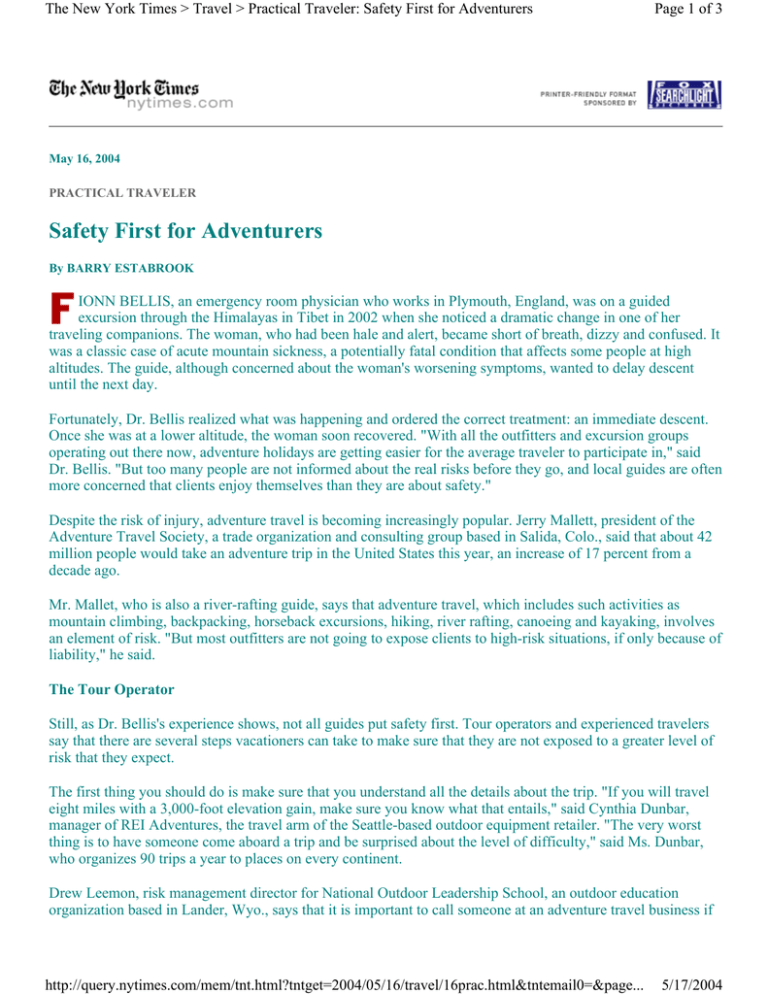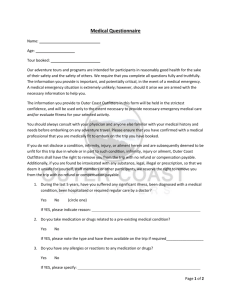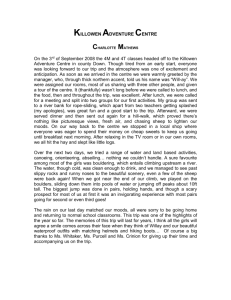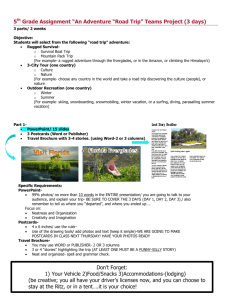Safety First for Adventurers
advertisement

The New York Times > Travel > Practical Traveler: Safety First for Adventurers Page 1 of 3 May 16, 2004 PRACTICAL TRAVELER Safety First for Adventurers By BARRY ESTABROOK IONN BELLIS, an emergency room physician who works in Plymouth, England, was on a guided excursion through the Himalayas in Tibet in 2002 when she noticed a dramatic change in one of her traveling companions. The woman, who had been hale and alert, became short of breath, dizzy and confused. It was a classic case of acute mountain sickness, a potentially fatal condition that affects some people at high altitudes. The guide, although concerned about the woman's worsening symptoms, wanted to delay descent until the next day. Fortunately, Dr. Bellis realized what was happening and ordered the correct treatment: an immediate descent. Once she was at a lower altitude, the woman soon recovered. "With all the outfitters and excursion groups operating out there now, adventure holidays are getting easier for the average traveler to participate in," said Dr. Bellis. "But too many people are not informed about the real risks before they go, and local guides are often more concerned that clients enjoy themselves than they are about safety." Despite the risk of injury, adventure travel is becoming increasingly popular. Jerry Mallett, president of the Adventure Travel Society, a trade organization and consulting group based in Salida, Colo., said that about 42 million people would take an adventure trip in the United States this year, an increase of 17 percent from a decade ago. Mr. Mallet, who is also a river-rafting guide, says that adventure travel, which includes such activities as mountain climbing, backpacking, horseback excursions, hiking, river rafting, canoeing and kayaking, involves an element of risk. "But most outfitters are not going to expose clients to high-risk situations, if only because of liability," he said. The Tour Operator Still, as Dr. Bellis's experience shows, not all guides put safety first. Tour operators and experienced travelers say that there are several steps vacationers can take to make sure that they are not exposed to a greater level of risk that they expect. The first thing you should do is make sure that you understand all the details about the trip. "If you will travel eight miles with a 3,000-foot elevation gain, make sure you know what that entails," said Cynthia Dunbar, manager of REI Adventures, the travel arm of the Seattle-based outdoor equipment retailer. "The very worst thing is to have someone come aboard a trip and be surprised about the level of difficulty," said Ms. Dunbar, who organizes 90 trips a year to places on every continent. Drew Leemon, risk management director for National Outdoor Leadership School, an outdoor education organization based in Lander, Wyo., says that it is important to call someone at an adventure travel business if http://query.nytimes.com/mem/tnt.html?tntget=2004/05/16/travel/16prac.html&tntemail0=&page... 5/17/2004 The New York Times > Travel > Practical Traveler: Safety First for Adventurers Page 2 of 3 you have not dealt with the company before. "One thing to ask about is how long they have been in business,'' he said. "If it's 10 or 20 years, that gives you some indication that they are doing something right. Then you want to ask if they have credentials. For every activity and region, there are different certification bodies - river guides, mountain guides, boatmen. Make sure that your outfitter is accredited with the appropriate one, either through the company itself or through individual guides." He also recommends talking to people who have been on the trip you plan to take. "This is a word-of-mouth business, so don't be shy about asking an outfitter if you can talk to one of his clients, and if he won't give you names, that might be reason to wonder. "I'd also be hesitant if I called a guide and the person on the phone painted an overly positive picture of the level of risk involved, or if someone guarantees you total safety. The fact is that there are inherent risks in these activities. You can get hurt. Once you are on a trip, it's important to communicate with your guide if you are having any problems. "A good guide will be reading the group constantly, but I have seen situations where a guide hikes ahead until he's out of sight of the group," said Mr. Leemon. "Leaders who do these trips all the time can get complacent and not pay attention. Ultimately, the onus is on you to speak up." Is First Aid Available? Even with the best preparation, injuries can happen. For that reason, Martha Gaughen, an Atlanta-based travel agent who specializes in adventure travel, suggests that vacationers ask guides and outfitters whether there will be anybody on the trip qualified to give first aid and medical assistance, and what evacuation plans the organization has in the event of an emergency. "I also suggest that travelers ascertain what sort of safety equipment the outfitter uses, which of course varies according to the activity," said Ms. Gaughen. "If it's a bike tour, you want to know about the type of bikes and helmets; if it's river rafting, you want to ask about life jackets and helmets." Adventure travelers can also fall ill in foreign countries, so Ms. Gaughen advises her clients to make absolutely certain that they have the proper immunizations before they set out. The Web site of the Centers for Disease Control and Prevention (www.cdc.gov/travel) has information about travelers' health issues. Another worthwhile precaution, according to Ms. Dunbar of REI is to invest in a travel insurance policy that will cover not only the costs of medical emergencies while on vacation but will also reimburse any money forfeited if you have to cancel your trip for health reasons. "Every year we have someone who has to cancel because they experience an injury while training to get in condition for one of our trips," she said. There are some adventure activities that travel insurers won't cover, said Daniel McGinnity, a vice president with Travel Guard International, a travel insurer. "Typically, policies exclude technical mountain climbing not hiking, but climbing that involves ropes and clips," he said. "Hang gliding and hot-air ballooning are also excluded, along with any form of flight that's not aboard a scheduled or chartered aircraft." The good news is that injuries are rare on adventure trips. In a study published in 2003 in the journal Wilderness and Environmental Medicine, Dr. David Fiore of the University of Nevada School of Medicine in Reno reported that the injury rate among the almost 10 million people who go white-water rafting each year was about three to five per 1,000 boater days. http://query.nytimes.com/mem/tnt.html?tntget=2004/05/16/travel/16prac.html&tntemail0=&page... 5/17/2004 The New York Times > Travel > Practical Traveler: Safety First for Adventurers Page 3 of 3 According to records that have been kept since 1984 by the National Outdoor Leadership School, the vast majority of injuries experienced on the school's backpacking expeditions, horseback excursions, river-rafting courses and canoe trips are sprains and strains, usually to the knees, ankles or lower back. "Slipping or falling is the most common cause," Mr. Leemon said. Surprisingly enough, the most likely place to be injured on his organization's trips is not on steep, rocky trails or in seething rapids. It's at the campsites. "We're not talking about major falls, just little slips and trips," he said. "People get their tents up, dinner is cooking, and I guess they let their guard down." BARRY ESTABROOK contributes to the Travel section regularly. Copyright 2004 The New York Times Company | Home | Privacy Policy | Search | Corrections | Help | Back to Top http://query.nytimes.com/mem/tnt.html?tntget=2004/05/16/travel/16prac.html&tntemail0=&page... 5/17/2004





